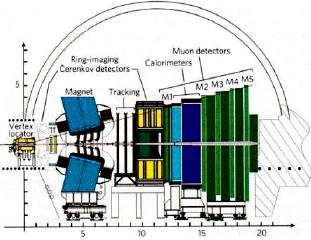Taking a closer look at LHC
The visible universe is composed of matter particles - protons, neutrons and electrons - rather than their antimatter partners - antiprotons, antineutrons and positrons.
The Big Bang should have created equal amounts of matter and antimatter. Why is there now so much of one and so little of the other?
CP (C: Charge conjugation - P: parity) violation -an effect seen only with certain kinds of elementary particles- could provide the answer.
Andrei Sakharov in 1967 laid out three conditions that would enable a universe containing initially equal amounts of matter and antimatter to evolve into a matter-dominated universe, which we see today.
- The first requirement was that the proton should be unstable. For example, it would be possible this process:
p → e+ + π0
(proton → positron + pion)
- The second was that there would be interactions violating C and CP (discussed below).
- The third condition was that the universe would undergo a phase of extremely rapid expansion: otherwise, matter and antimatter particles, having equal masses, would be fated to pair up with equal densities.
The favoured theoretical framework for CP violation was provided in 1973 by Makoto Kobayashi and Toshihide Maskawa (Nobel Prize in 2008, with Yoichiro Nambu), who pointed out that CP violation would follow automatically if there were at least six quark flavours.
CP symmetry refers to the fact that physical processes in nature occur in precisely the same manner if all particles were converted to their antimatter opposites using the CP transformation.
Explicitly, Parity is a property important in the quantum-mechanical description of a physical system. In most cases, it relates to the symmetry of the wave function representing a system of fundamental particles A parity transformation replaces such a system with a type of mirror image. Stated mathematically, the spatial coordinates describing the system are inverted through the point at the origin; that is, the coordinates x, y, and z are replaced with -x, -y, and -z.
In general, if a system is identical to the original system after a parity transformation, the system is said to have even parity. If the final formulation is the negative of the original, its parity is odd. For either parity the physical observables, which depend on the square of the wave function, are unchanged. A complex system has an overall parity that is the product of the parities of its components.
|
More significantly, P reverses the relationship between the intrinsic angular momentum (spin) of a particle and the direction of its velocity. If the spin is aligned with the velocity, the particle is referred to as having "positive helicity". If the spin is anti-parallel to the velocity direction, the particle has "negative helicity". Under a P transformation, the velocity direction is reversed but the spin direction is not (as spin is a purely internal quantum number); thus a positive helicity particle ⇒ negative helicity and vice versa. Until 1956 it was assumed that when an isolated system of fundamental particles interacts the overall parity remains the same, or is conserved. In attempting to understand some puzzles in the decay of particles called K mesons, the Chinese-born physicists Tsung-Dao Lee and Chen Ning Yang proposed in 1956 that parity is not always conserved. The following year (1957), Chien Shiung Wu, from her famous experiment, conclusively provedthat the electrons ejected along with antineutrinos from certain unstable cobalt nuclei in the process of beta decay, a weak interaction, are predominantly left-handed--that is to say, the spin rotation of the electrons is that of a left-handed screw. Tsung-Dao Lee and Chen Ning Yang were awarded the 1957Nobel Prize in physics, but Chien Shiung Wu did not share it, despite support from the physics community in favor of including her in the prize. |
Conservation of Parity
No Conservation of Parity |
The C operation reverses all additive quantum numbers such as electric charge, hypercharge, strangeness, etc. So, for example, under a CP transformation, a negative helicity proton becomes a positive helicity antiproton.
It was first predicted - and subsequently confirmed by experiment (in the 1950’s) - that positive and negative helicity particles interact differently: a negative helicity electron will scatter off a nucleus and transform into a neutrino, but a positive helicity electron will not. However,a positive helicity positron will, just like the negative helicity electron. This is an example of CP symmetry.
If the universe would remain unchanged after being through a transformation, we say that it issymmetric, or invariant, under that transformation. The symmetry CP was believed to be exact until 1964.
In this year James Cronin and Val Fitch of Brookhaven National Laboratory discovered a slight anomaly in the decay of a particle called the neutral K-meson, or neutral kaon. That anomaly was the fingerprint of a failure of CP invariance – in other words, of CP violation.
For this work earned Fitch and Cronin the 1980 Nobel Prize in Physics.
The effects of the direct type of CP violation are extremely subtle to detect, and weren’tdiscovered until 1999, in experiments on K mesons at CERN in Geneva and at the Fermi National Laboratory in Illinois (USA).
Accurate measurements have taken place to determine the origin of CP violation in the K-meson system. However, with the K-meson effects due to the strong interaction are too large to draw any conclusion about the origin of CP violation. The expectation is that these effects will be less and better to determine in the case of a heavier meson such as the B-meson.
| A B meson consists of a b-antiquark (called "b-bar") and either a u- or d-quark(these are the two lightest quarks). Its antiparticle, called the B antimeson or "B-bar" meson, is made up of a b-quark and a u- or d- antiquark (u-bar or d-bar). Two experiments in the world have been carried out to measure CP violation in B decay: BaBar (PEP-II - Stanford, USA) andBELLE (KEK -Tsukuba, Japan). |
 |
|
The LHCb experiment is dedicated to study CP violation processes in decays ofB mesons. The LHC will be by far the most copious source of BA variety of b-hadrons, such as Bu, Bd, Bs, Bc and b-baryons, are produced at high rate. The experiment will be able to uniquely identify particles by means of (RICH) Cherenkow counters, electromagnetic and hadron calorimeters and a muon detector. mesons, due to the high cross section and high luminosity. |
 |
Observation of charge–parity symmetry breaking in baryon decays.
July 2025
A new piece in the matter–antimatter puzzle.
At the annual Rencontres de Moriond conference taking place in La Thuile, Italy, the LHCb collaboration at CERN reported a new milestone in our understanding of the subtle yet profound differences between matter and antimatter.
The LHCb collaboration observed CP violation in the beauty-lambda baryon Λb, which is composed of an up quark, a down quark and a beauty quark.

Illustration Λb production and decay (Image Nature)
The analysis showed that the difference between the numbers of Λb and anti-Λb decays, divided by the sum of the two, differs by 2.45% from zero with an uncertainty of about 0.47%. Statistically speaking, the result differs from zero by 5.2 standard deviations, which is above the threshold required to claim an observation of the existence of CP violation in this baryon decay.
The paper "Observation of charge-parity symmetry breaking in baryon decays" was published in the journal Nature.
The experimental High Energy Physics Group at the University of Santiago de Compostela focuses its research activity in quark physics, trying to probe the limits of the Standard Model. The main current project is Flavour Physics and CP-violation at the LHCb experiment at CERN.
In RUN 1, the LHCb detector saw for B meson decay that the electron decay pathway occurring 25% more often, which could suggest the in uence of particles beyond the standard model. But further examples in RUN 2 are needed to confirm that this is not a statistical fl uke.
In March 2019 (Rencontres de Moriond), the LHCb collaboration at CERN has presented for the first time, the matter–antimatter asymmetry known as CP violation in a particle dubbed the D0 meson. To observe this CP asymmetry, the LHCb researchers used the full dataset delivered by the Large Hadron Collider (LHC) to the LHCb experiment between 2011 and 2018 to look for decays of the D0 meson (this meson is made of a charm quark and an up antiquark and its antiparticle, the anti-D0, into either kaons or pions). CP violation is an essential feature of our universe, necessary to induce the processes that, following the Big Bang, established the abundance of matter over antimatter that we observe in the present-day universe. So far, CP violation has only been observed in particles containing a strange or a bottom quark.
“The result is a milestone in the history of particle physics. Ever since the discovery of the D meson more than 40 years ago, particle physicists have suspected that CP violation also occurs in this system, but it was only now, using essentially the full data sample collected by the experiment, that the LHCb collaboration has finally been able to observe the effect,” said CERN Director for Research and Computing, Eckhard Elsen.
T operation (Time Reversal)
T corresponds to the operation of reversing the direction of Time. If invariant under the T operation, a particle reaction which changes an initial state to a final state can also change the final state back to the initial state.
Although it is now clear that the laws of physics are not invariant under C, P, or CP, scientists are still optimistic that the ultimate discrete symmetry CPT is not broken.
So, the mirror image of the antimatter world with time running backwards should look exactly the same as ours.
|
AUTHORS Xabier Cid Vidal, PhD in experimental Particle Physics for Santiago University (USC). Research Fellow in experimental Particle Physics at CERN from January 2013 to Decembre 2015. He was until 2022 linked to the Department of Particle Physics of the USC as a "Juan de La Cierva", "Ramon y Cajal" fellow (Spanish Postdoctoral Senior Grants), and Associate Professor. Since 2023 is Senior Lecturer in that Department.(ORCID). Ramon Cid Manzano, until his retirement in 2020 was secondary school Physics Teacher at IES de SAR (Santiago - Spain), and part-time Lecturer (Profesor Asociado) in Faculty of Education at the University of Santiago (Spain). He has a Degree in Physics and a Degree in Chemistry, and he is PhD for Santiago University (USC) (ORCID). |
CERN CERN Experimental Physics Department CERN and the Environment |
LHC |
IMPORTANT NOTICE
For the bibliography used when writing this Section please go to the References Section
© Xabier Cid Vidal & Ramon Cid - rcid@lhc-closer.es | SANTIAGO (SPAIN) |





